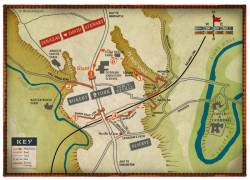

 Henry 2nd Lord Percy
Henry 2nd Lord Percy 


General Notes
Second Lord Percy of Alnwick (1315 - 1352). Fought with Edward The Black Prince in France 1347, and for many years against border raids by the Scots.
The Battle of Neville’s Cross in 1346.
Although border warfare was common in the Middle Ages, this battle had its immediate origins in an Anglo/ French dispute in Europe. Two months before the Neville’s Cross battle, in August 1346, an English army, under King Edward III, had defeated a French army at CrÈcy in Northern France. The Scots, commanded by their King, David II, were responding to an appeal from the King of France to create a diversion in Northern England.
The Scottish army crossed the border north of Carlisle and moved down the north bank of the Tyne, taking Hexham and Corbridge. Legend has it that, the night before the fording of the Tyne at Ryton, David had a dream warning him not to invade the territory of Saint Cuthbert. Ignoring this warning, David’s army moved south and encamped at Beaurepaire (Bearpark) outside Durham City. The English had not been idle and troops were gathered at Richmond under Ralph Neville, Henry Percy and the Archbishop of York. The English army advanced to Barnard Castle and then to Bishop Auckland. An English mounted force advancing from Merrington ran into a Scottish raiding party and, in a running battle south of Durham between Thinford and Sunderland Bridge, forced the Scots to retreat with heavy casualties. It is said that this is why the area is now known as Butcher Race.
The night before the battle St Cuthbert is said to have appeared to John Fossor, Prior of the Benedictine Abbey of Durham, and instructed him to take the saint’s banner to the battlefield. Maiden’s Bower is the site at which Prior Fossor and a number of monks spent the battle in prayer. Following the battle a wooden cross was erected on Maiden’s Bower and as the monks made their journeys to and from Beaurepaire they would turn into Flass Vale and offer prayers by the cross. The cross was broken down in the mid-sixteenth century.
On the morning of 17th October, the English army (possibly as few as 5,000 men) was formed up across Crossgate Moor in three divisions, with a reserve contingent held in the rear. The larger Scottish force (possibly 16,000 men) moved out from Beaurepaire and formed up in their three divisions north of Arbour House Farm.
The line of advance of the Scottish right wing under Sir William Douglas took it into this valley where it was hampered by the descent down the steep slopes and the ditches and fences which intersected the land in the valley bottom. Confusion resulted, with the cohesion of the three schiltrons (‘hedgehog-like’ formations of pikes) lost. The Scots also had to climb the slope in front of Sir Thomas Rokeby’s men who were the bulk of the English archers.
The right wing of the English army - the men of Northumberland commanded by Henry Percy. This wing did not have the early success of its counterpart on the left and, as the opposing Scottish troops under Robert Stewart advanced, the English soldiers were forced back by Scottish spears. As Percy’s troops gave ground they kept contact with the English centre and swung back pivoting on their left flank. The advancing Scots then exposed their own left flank to a counter-attack by the English reserve which had been held back behind the line of battle. Under attack Stewart pulled many of his troops back from the field.
The Scots’ centre, under the command of King David, was now exposed by the withdrawal of Stewart’s division on the left and the defeat of Douglas’ division on the right. The English troops closed around the Scottish centre and sheer weight of numbers now began to tell. David’s standard bearer was killed and the King himself was wounded before he was eventually captured by John Copeland. The defeated and leaderless remnants of the Scots army streamed northwards fighting small-scale actions, including one on Findon Hill. King David was taken to a Northumbrian castle for safety and he was eventually handed over to Edward III. He remained in English custody for 11 years and was freed in exchange for a £66,000 ransom which is the equivalent of about £15 million in today’s terms!
After the battle Ralph Neville erected a new cross to commemorate the victory.
-
Individual Additional Information
-
Associated external link media/ind00071.htm
 Details of Henry's family with Eleanor de Arundle
Details of Henry's family with Eleanor de Arundle
Page last modified
This page is within a frameset. View the entire genealogy report of 2nd Lord Percy families, or surname index of 2nd Lord Percy pedigrees or report summary 2nd Lord Percy heritage from 'Moore, Simpson, Ballard Family Tree - England and Scotland to Australia'.
HTML generator.
Copyright © 2011 GenoPro Inc. All rights reserved.




